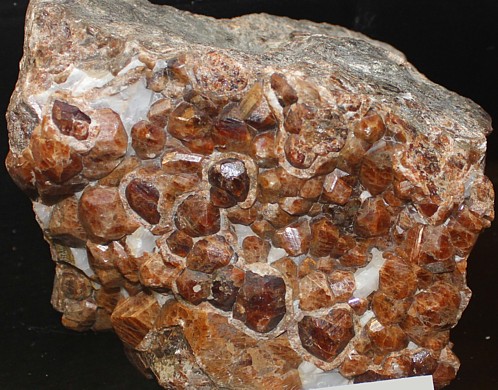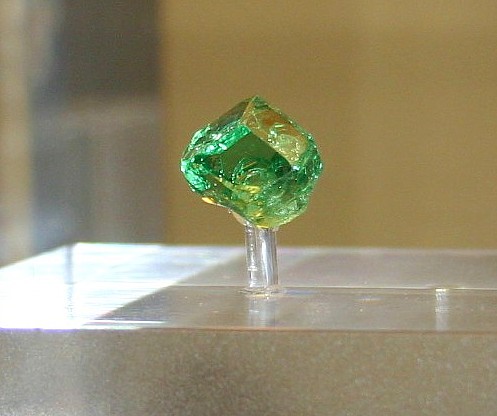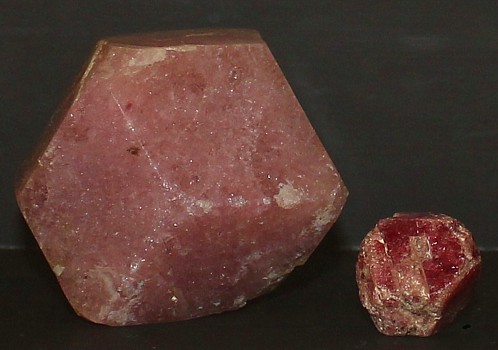|
.
Grossularite Mineral Facts:
Chemical
Formula: Ca3Al2(SiO4)3
Calcium
aluminum garnet. Often contains ferrous iron replacing calcium and
ferric iron replacing aluminum.
Colors:
Colorless, white, green,
yellow, orange,
cinnamon-brown, pale red and occasionally pink.
Pure specimens are colorless. Colored varieties contain impurities such
as iron, vanadium, manganese and other elements which give this garnet
its color.
Hardness:
7
Density: 3.4
to 3.6
Cleavage:
None.
Crystallography: Isometric, hexoctahedral
Usually distinctly
crystallized; also in rounded grains; massive granular, coarse or fine.
When crystalized, commonly forms dodecahedron and trapezohedron, often
in combination. Hexoctahedron observed at times.
Luster:.
Vitreous glassy
luster. It is transparent or translucent.
Optics:
(Refractive Index):
= 1.7438
|

Grossularite Garnet, Nevada |
|
Composition,
Structure and Associated Minerals:
Grossular, with its Calcium and aluminum content, is characteristic of metamorphosed
impure limestones, in which it occurs associated
with other lime silicates, idocrase, scapolite, etc. Grossularite is found
chiefly as a product of contact or regional metamorphism in crystalline
limestone especially where acidic rocks like granite are intruded into
limestone.
Grossularite, Essonite, Hessonite, or Cinnamon Garnet occurs in crystalline
schists and in metamorphosed limestones, where it is associated with other
calcium silicates. It is found also in quartz veins.
The name derived from the botanical name for gooseberry, in allusion to the
light green color of the original grossularite.
Under the
influence of the air and moisture garnets often alters to other minerals,
being partially or entirely changed to
epidote, talc, muscovite,
chlorite, serpentine, and occasionally
to other substances.
Identification and Diagnostics
Fusible
before the
blowpipe flame. Garnets, when in crystals, are easily distinguished
from other similarly crystallizing substances by their characteristic
isometric crystals, color and hardness, etc. Massive garnet may resemble vesuvianite,
sphene, zircon or
tourmaline. It is distinguished from
zircon by its easier fusibility and from vesuvianite by its more difficult
fusibility; from tourmaline by its higher specific gravity, and from sphene
by the reaction from titanium.
It frequently requires a chemical
analysis to positively distinguish between the different members of the
group, or the percentages of each molecule in an individual specimen.
Occurrence,
Localities and Origins:
The mineral is white, bright yellow, cinnamon-brown or some pale shade of
green or red. The lighter-colored varieties are often transparent or nearly
so. Those that are both transparent and well colored are used as gems. Much
of the hyacinth of the jewelers is an orange to red colored grossularite.
The best known historical source of gem hessonite is Sri Lanka, where it
occurs in the gem gravels, notably in the Matura district.
In recent decades, large amounts
of fine gem quality grossular garnet has come from Africa, principally
Tanzania and Kenya. Some are orange colored, another source produces pale
yellow, near colorless and light green varieties. However the best known
variety of this garnet is the Tsavorite, a medium to deep green garnet
colored by vanadium. Tsavorite has become the most valuable garnet
type with a high price per carat for good quality stones. Its color comes
close to that of a fine
emerald with brighter optical characteristics and without the typical
flaws.
Good crystals of grossularite
occur at Phippsburg, Raymond and
Rumford, in Maine, and at many other places both in this country and abroad.
Bright yellow varieties are reported from Canyon City, Colorado.
Return to the
Mineral Collectors Information Page |

Grossular Garnet, Variety Tsavorite |
|



